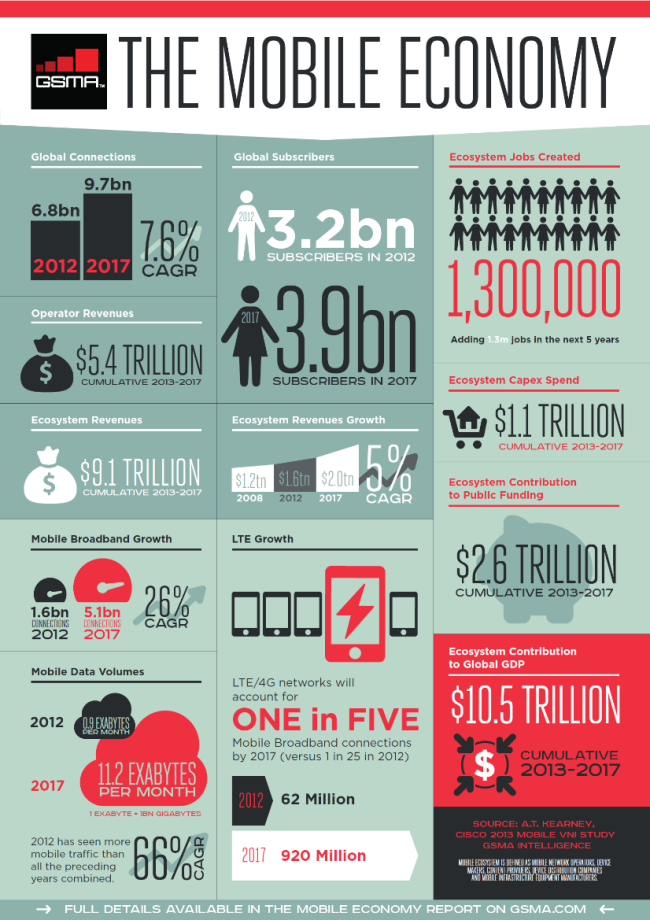Emerging markets will be the key source of future mobile communications growth with 1.6bn new connections coming from around the world, out of which 61pc of these will come from Asia.
At the Mobile World Congress in Barcelona, Nokia CEO Stephen Elop said that bringing the next 1bn users online will be a major disruptive force for the industry. He unveiled the new Nokia 105 device, the first full colour device with internet and email connectivity that will cost less than US$15.
More coverage from the Mobile World Congress:
Data to overtake voice by 2018, GSMA predicts at #MWC13
Bango and Telefónica to bring app buying power to mobile bills
Altobridge raises US$7.8m from Intel and World Bank
Microsoft and Nokia explain quality over quantity game plan at #MWC13
Google at #MWC13: Google Play is growing faster than Android
Operators at #MWC13: the golden age of mobile faces challenges
Sony launches Xperia Tablet Z: ‘2013 will be the year of the Android tablet’
O2 to launch TuGo app that turns voice calls into a multi-screen experience
Samsung reveals its 8-inch tablet Galaxy Note 8.0
Firefox OS: walled gardens between web and apps to be demolished
Elop said: “We believe that the next 1bn people are very young and very ambitious. For the very first time they are able to afford their own mobile phone, it is not a device they have to share with their family or the village. It’s their own.”
Manoj Kohli, the CEO of India-headquartered Bharti Airtel, the third largest mobile operator in the world with 261m subscribers in 20 countries, said that for every 10pc increase in broadband penetration in a developing country there is a 1pc increase in GDP.
He said there is a need for mobile devices that cost less than US$30 and mobile broadband dongles that cost less than US$10.
At the Mobile World Congress browser creator Mozilla revealed its Firefox OS that will be included on devices from LG, Huawei, Alcatel and ZTE to bring affordable smartphones into the hands of consumers in developing markets. Operators from America Movil, China Unicom, Deutsche Telekom, Etilisat, Hutchison Three, KDDI, KT, MegaFon, Qtel, SingTel, Smart, Sprint, Telecom Italia, Telefónica, Telenor, TMN and VimpelCom have undertaken to carry smartphone devices from the various mobile manufacturers who have committed to the new Firefox OS.
According to the GSMA, there are 3.4bn people on the planet today connected by mobile devices and this will grow to 3.9bn by 2017.
4G LTE will account for one in five connections in the world versus one out of every 25 in 2012.
The GSMA estimates that the industry is expected to spend US$1.1trn on capex in the next five years and will add 1.3m jobs around the world. The mobile industry’s contribution to global GDP between 2013 and 2017 as a result of its investment is expected to add up to US$10.5trn.
The big three emerging markets
“Emerging markets continue to feature heavily in the keynote speeches at MWC 2013, with both Nokia and Bharti Airtel’s CEO highlighting that the next billion internet connections will come from mobile users in emerging markets,” said Carrie Pawsey, telco strategy analyst at Ovum.
“Ovum forecasts that emerging markets will be the key source of future mobile connections growth, particularly in Africa and Asia-Pacific. Between 2012 and 2017, Ovum expects that there will be 1.6bn new mobile connections across the world, with 61pc of these coming from Asia-Pacific.
“While connections growth in Asia-Pacific will begin to slow towards the end of our forecast period, the region’s 4.4bn connections in 2017 will make it the greatest contributor to global connections. Growth in the Asia-Pacific region will largely be driven by the big three emerging markets of China, India, and Indonesia, which will have 3bn connections between them in 2017.
“While Asia-Pacific will generate the most new connections, Africa will be the fastest-growing region. African mobile connections will grow at a compound annual growth rate of 6.5pc between 2012 and 2017, increasing from 683m in 2012 to 935m in 2017.
“While connections growth is important, the biggest issue for emerging market operators will continue to be around revenue growth and how to remain profitable with a customer base of low-ARPU users.
“Both Nokia and Airtel’s CEOs talked about the need for cheaper devices. The strategies of operators in Vietnam, India, Pakistan, and Tanzania demonstrate how telcos can operate in markets where ARPU is below US$3 per month.
“While the correlation between high ARPU and profitability is not absolute, operators still need to take action to improve the amount of revenue that they make from each connection. This is of paramount importance to operators in markets where ARPU will be less than US$5 per month in 2017,” Pawsey said.
Below: GSMA infographic highlighting the potential scale of the global mobile economy
